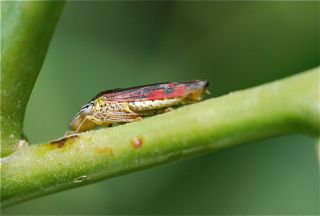This week, instead of looking at just insects, we are going to take a close look at the flowers of an amazing plant.

This plant is commonly called “red bird of paradise†or “Pride of Barbados,†Caesalpinia pulcherrima. The flowers are a burst of vibrant color, almost like flames. As a photographer, I love the bizarre structures and shapes. As a scientist, I tend to start asking questions. While taking a few photographs, I became more and more curious about these remarkable flowers.

First I found honey bees and wasps walking over the buds in the upper center of the flower cluster, like they were gathering nectar.

Sometimes plants have nectaries, the organs that produce the sweet fluid nectar, on places outside of the flower itself. I couldn’t find any text to support my idea, but I did find a photograph. After you click on this link, check the photograph carefully. Look for the whitish crystals at the bases of the interior buds. Looks to me like sweet nectar that has flowed from nectaries and then dried. By the way, nectaries found outside of the flower are called extrafloral nectaries by botanists.
Bees and wasps were also visiting the flowers, so apparently the flowers provide nectar too. (There are some plants with flowers that provide only pollen).
Next I found small bees and flies that were rubbing on the long, hair-like projections.

Those are the male parts of the flower, called the stamens. At the tip of each stamen (the stalk is called the filament) is the anther, which produces the pollen. Look at these flowers. To be pollinated, pollen must get from the anthers to the stigma, or female part of the flower. But first the pollinator must pick up the pollen. Just what kind of pollinator could pick up pollen from the long stalk-like stamens when its head was drinking nectar from the flower interior? The pollinator must be something fairly big by the looks.
Who are some possibilities? While watching I saw honey bees, carpenter bees, wasps, digger bees, flower flies and even a dragonfly lurking nearby. None of these seemed big enough.

The dragonfly was probably catching some of the small flies that were visiting the flowers for nectar.
Doing some research, I found that red bird of paradise flowers are pollinated by two different groups of animals. Scientists have shown that the red bird of paradise is pollinated by large butterflies, at least in some areas. Remember the pipevine swallowtail I showed last week? Many of the swallowtails flutter their wings while feeding on nectar at flowers. The butterflies get the pollen on their wings while they are feeding by brushing up against the stamens, then pass off the pollen to the female part or stigma at the next flower they visit.
In addition to butterflies, hummingbirds also visit and pollinate this plant.
Next time you are in the tropics or other places where one of these astonishing plants grows, take a look at the incredible complexity of these unbelievable flowers.
One my favorite books about flowers for children is The Reason for a Flower by Ruth Heller. The illustrations are wonderful. The text is extremely detailed, even though it is in rhyme. How does she get all that information packed into so few words? Be aware there are two places where inaccuracies creep in. On one page she shows the male parts as an anther on a stamen as parallel to a the female parts of stigma on a style. Technically the entire male structure is called a stamen, so it probably should be “from an anther on a filament.” Towards the end she also calls a mushroom a plant, which is a very outdated classification scheme. Fungi are now in their own separate kingdom. Look past these technical slips and the book is overall still a gem.










